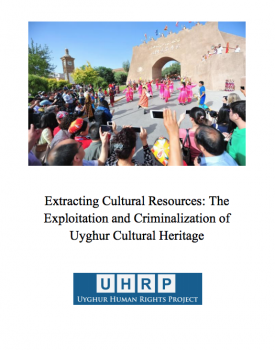UHRP REPORT: Extracting Cultural Resources: the Exploitation and Criminalization of Uyghur Cultural Heritage

For immediate Release
June 12, 2018, 11:00 am EST
Contact: Uyghur Human Rights Project +1 (202) 478 1920
A new report by the Uyghur Human Rights Project entitled “Extracting Cultural Resources: the Exploitation and Criminalization of Uyghur Cultural Heritage” examines the history and current state of government control of Uyghur cultural expression and the place of China’s cultural policies in the ongoing assimilative campaign in East Turkestan. The room for Uyghurs to maintain and develop their traditions is narrowing. Many traditional cultural practices have been transformed into propaganda campaigns, tourist offerings or in some cases completely banned.
To examine the increasingly repressive and assimilative cultural policies being enacted by the government, this report utilizes the concept of intangible cultural heritage (ICH)- those aspects of cultural expression which do not include the artworks and monuments traditionally thought of as cultural heritage, such as music, dance, craftsmanship and oral history. The United Nations Educational, Scientific and Cultural Organization (UNESCO) currently extends recognition to two items of Uyghur ICH at the international level; the suites of classical musical known as the Muqam and the Meshrep, a traditional event which served as a platform for a wide variety of Uyghur cultural expressions including music, dance, and oral history.
“China’s cultural policies do not help preserve the world’s cultural diversity. Instead cultural heritage of the Uyghurs is assessed for its utility for preserving the Party’s power or developing the tourism industry. If the authorities believe a traditional practice is in any way a threat, as is the case with shrine pilgrimage or traditional meshrep gatherings, it will be banned,” said UHRP’s Director, Omer Kanat. “Cultural rights are directly connected to fundamental rights like freedom of speech, assembly, religion and the right to use one’s mother tongue. The world should pay attention to what the Chinese authorities are doing to Uyghur cultural traditions because they are a vital part of maintaining identity, which the government appears determined to undermine.”
China seeks to frame minority cultures, such as the Uyghurs’, as small parts of Chinese national heritage, allowing them to take only narrow officially defined forms. Official Chinese policy states that ICH must help strengthen national unity and socialist values and serve as a tool for increasing national prestige and strength as defined by the Communist Party. The numerous laws and regulations on the preservation of ICH and the system of supporting and educating heritage bearers allow micromanagement of Uyghur cultural expression down to the grassroots level.
The official narrative regarding Uyghur culture is that the government is supporting cultural production though its ICH program and raising the cultural level of rural areas by sending official troupes to perform there, and that official policies are preserving Uyghur culture in the face of threats, namely the infiltration of religious extremism and hostile foreign forces. This justifies government management of Uyghur cultural expression. Official policy is highly focused on the use of Uyghur traditions as “cultural resources” which can be utilized to grow the tourism industry, which has become an important part of center-led economic development plans. Its growth facilitates the settlement of Han Chinese into the region as both short-term visitors and labor for the growing industry and provides additional justification for repressive securitization policies aimed at creating an impression of “stability.”
This report examines the government’s policies towards a wide variety of items of cultural heritage, including music, dance, folklore, architecture and clothing. The government has banned shrine festivals and shrine pilgrimages and distorted the meshrep from a community-based activity into a vehicle for CCP propaganda. This means that Uyghur culture is being transformed into nothing more than the symbolic diversity of clothing and dance enforced by authorities from above even as the government’s assimilative policies intensify.
This campaign is taking the form of pressuring Uyghurs to publicly perform modern dances, sing Communist “Red Songs,” wear pseudo- traditional Chinese robes, and celebrate Chinese New Year. This is taking place against the backdrop of a massive crackdown, including the imprisonment of hundreds of thousands of Uyghurs in re-education camps. Uyghur’s cultural marginalization parallels their economic and political marginalization. Controlling or forbidding traditional or Uyghur-led cultural expressions are not only a violation of individual rights to free speech, assembly and religion, but are also violations of their communal cultural rights, threatening the ability of Uyghurs to define and maintain their own identity.
“Extracting Cultural Resources: the Exploitation and Criminalization of Uyghur Cultural Heritage” can be downloaded at: https://docs.uhrp.org/pdf/CulturalResourcesIntangibleHeritage.pdf
